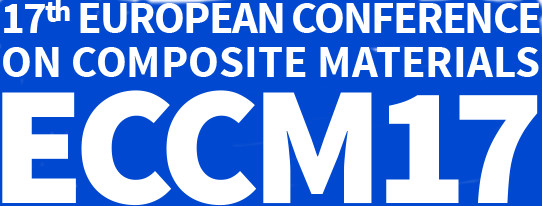

App-Einstellungen:
NON-DESTRUCTIVE DETERMINATION OF MORPHOLOGICAL PARAMETERS OF POLYMER BASED PARTICLE COMPOSITES BY MEASURING PERMITTIVITY
Jörg Bossert (Friedrich Schiller University Jena) Mike Mühlstädt (Friedrich Schiller University Jena) Matthias Arras (Friedrich Schiller University Jena) Klaus D. Jandt (Friedrich Schiller University Jena)
This preliminary study demonstrates that the presented technique can be considered as a promissing non-destructive testing method for monitoring the integrity of shear-sensitive flaky particles embedded in a polymer matrix.
NUCLEATING ACTIVITY OF CORK IN POLYPROPYLENE-BASED COMPOSITES
Sara Magalhães da Silva (University of Aveiro) Paulo Silva Lima (Universidade de Aveiro) José Martinho Oliveira (Universidade de Aveiro)
The nucleating activity (Φ) of cork-polymer composites (CPC) in a polypropylene (PP) matrix was analyzed by Dobreva and Gutzow method. Results suggest that cork can act as a nucleating agent during non-isothermal crystallization.
OPTIMIZATION OF HEAT FUSION OF THERMOPLASTIC RESIN BY MOLECULAR DYNAMICS AND A RESPONSE SURFACE METHOD
Kento Takeuchi (Tokyo University of science) Ryosuke Matsuzaki Tomonaga Okabe (Tohoku University) Yutaka Oya (Tohoku University)
We simulated heat fusion and uniaxial elongation of thermoplastic resins by MD simulation and optimized heat fusion condition by response surface method. We obtained optimum condition and the interfacial strength of optimum model is the highest.
AN INTERFACE MODEL OF THE FIBER PULLOUT PROCESS OF THE CARBON NANOTUBES (CNT) HYBRIDIZED CARBON FIBER (HCF) COMPOSITES
Zhang Yao (Institute of Soild Mechanics, Beihang University) Zixing Lu (Institute of Soild Mechanics, Beihang University) Zhenyu Yang (Beihang University)
An interface model which combines the CNT pullout theory and the cohesive zone model is proposed for analyzing interfacial shear strength during fiber pullout process of the hybridized carbon fiber composites.
EFFECT OF ATMOSPHERIC PRESSURE PLASMA TREATMENT ON INTERFACIAL BONDING OF CF/PP COMPOSITES
Mototsugu Tanaka (Kanazawa Institute of Technology) Naoki Osawa (Kanazawa Institute of Technology) Tomotaka Kitagawa (Kanazawa Institute of Technology) Takumi Okumura (Kanazawa Institute of Technology) Miho Onodera (Kanazawa Institute of Technology) Tomoya Nagano (Kanazawa Institute of Technology) Masatoshi Orito (Kanazawa Institute of Technology) Manato Kanesaki (Kanazawa Institute of Technology) Hiroshi Saito (Kanazawa Institute of Technology) Satoshi Osawa (Kanazawa Institute of Technology)
We developed a prototype, which can conduct the surface treatment of CFs and PP separately by the air dielectric barrier discharge. The effect of treatment condition on interfacial bonding was evaluated in UD-CF/PP films.
STUDY ON THE LOW FRICTION POLYMER FIBER STITCHED CARBON FIBER/PHENOLIC COMPOSITE MATERIALS FOR JOURNAL BEARING APPLICATION
Minhye Jung (Korea Institute of Carbon Convergence Technology(KCTECH)) Hyun Kyu Shin (Korea Institute of Carbon Convergence Technology(KCTECH)) Seong Su Kim (Chonbuk National University)
Composite journal bearings were fabricated using a carbon fiber/phenol composite by stitching the continuous carbon fiber fabrics along the thickness direction using a low friction polymer fibers to enhance the ILSS and the tribological properties.
THERMO-OXIDATIVE DEGRADATION OF CARBON FIBER SIZINGS AND ITS IMPACT ON THE MECHANICAL PERFORMANCE OF CARBON FIBER REINFORCED POLYPROPYLENE COMPOSITES
Christoph Unterweger (Kompetenzzentrum Holz GmbH) Jiri Duchoslav (Johannes Kepler University Linz) David Stifter (Johannes Kepler University Linz) Christian Fürst (Kompetenzzentrum Holz GmbH)
Thermo-oxidative stability of CF sizings during heat treatment experiments and processing was investigated by XPS. Alike the stability of the sizings, mechanical properties of PP/CF composites also displayed a dependency on processing temperature.
TITANIUM DIOXIDE NANOPARTICLES-COATED ARAMID FIBER SHOWING ENHANCED INTERFACIAL STRENGTH AND UV RESISTANCE PROPERTIES
Ben Wang (Xi’an Jiaotong University) Yugang Duan (Xi’an Jiaotong University) Jingjing Zhang (Xi’an Jiaotong University)
A developed low-temperature hydrothermal method was employed to grow TiO2 nanoparticle on the aramid fiber surface with the aim to enhance the poor interfacial strength and the UV resistance properties of the fiber material.
BIONANOCOMPOSITES BASED ON UNMODIFIED AND SURFACE MODIFIED NANOFIBRILLATED CELLULOSE EXTRACTED FROM WHEAT STRAW
Mandeep Singh (Panjab University) Anupama Kaushik (Panjab University)
TPS bionanocomposites were prepared by reinforcing unmodified and surface modified nanofibrillated cellulose. Study reported considerable improvement in the barrier properties the bionanocomposites reinforced with surface modified nanofibers.
EFFECT OF STACKING SEQUENCE ON LOW VELOCITY IMPACT AND POST-IMPACT BEHAVIOR OF FLAX/POLYAMIDE 11 COMPOSITES
Yann Lebaupin (estaca'lab) Michael Chauvin (estaca'lab) Thuy-Quynh Truong Hoang (estaca'lab) Fabienne Touchard (P' Institute)
In this paper, a fully biosourced composite: flax/Polyamide 11 is studied. Different stacking sequences are studied in order to investigate the lay-up effect on the impact and post impact behavior of these composites. Impact energy applied is 3.6 J.
